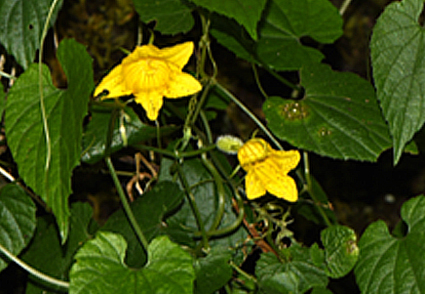Abstract
During field work on mutualisms between oil bees and Cucurbitaceae in Yunnan, China, we discovered a new species of Thladiantha that we here describe and illustrate. It is overall similar to T. globicarpa A.M.Lu & Zhi Y.Zhang from Guangxi, but differs in the shape of its fruits. DNA sequences of the new species analyzed in the context of a densely sampled phylogeny of Thladiantha confirm its distinctness from all other species. The molecular data also revealed another collection of the new species made in Guangxi in 1937. Like all Thladiantha, the new species offers oil in glandular hairs on its petals and is pollinated by oil-collecting Ctenoplectra bees.
References
- De Wilde, W.J.J.O. & Duyfjes, B.E.E. (2006) The subtribe Thladianthinae (Cucurbitaceae) in Indochina and Malesia. Blumea 51: 493–518. https://doi.org/10.3767/000651906X622076
- Jiang, W., Li, D.Z. & Wang, H. (2010) Thladiantha tomentosa (Cucurbitaceae) comb. nov. from southwestern China. Nordic Journal of Botany 28 (6): 699–701. https://doi.org/10.1111/j.1756-1051.2010.00758.x
- Kocyan, A., Zhang, L.-B., Schaefer, H. & Renner, S.S. (2007) A multi-locus chloroplast phylogeny for the Cucurbitaceae and its implications for character evolution and classification. Molecular Phylogenetics and Evolution 44: 553–577. https://doi.org/10.1016/j.ympev.2006.12.022
- Li, J.Q. (1997) On the systematics of Thaladiantha (Cucurbitaceae). Acta Botanica Yunnanica 19 (2): 103–127.
- Lu, A.M. & Zhang, Z.Y. (1981) A revision of genus Thladiantha Bunge (Cucurbitaceae). Bulletin of Botanical Research 1: 61–96.
- Lu, A.M. & Jeffrey, C. (2011) Cucurbitaceae. In: Wu, Z.Y., Raven, P.R. & Hong, D.Y. (Eds.) Flora of China. Vol. 19 (Cucurbitaceae through Valerianaceae, with Annonaceae and Berberidaceae). Science Press, Beijing, and Missouri Botanical Garden Press, St. Louis.
- Miller, M.A., Pfeiffer, W. & Schwartz, T. (2010) Creating the CIPRES Science gateway for inference of large phylogenetic trees. In: Proceedings of the Gateway Computing Environments Workshops (GCE). IEEE, New Orleans, USA, pp. 45–52. https://doi.org/10.1109/GCE.2010.5676129
- Raza, M., Ortiz, E.M., Schwung, L., Shigita, G. & Schaefer, H. (2023) Resolving the phylogeny of Thladiantha (Cucurbitaceae) with three different target capture pipelines. BMC Ecology and Evolution 23: 75. https://doi.org/10.1186/s12862-023-02185-z
- Schaefer, H. & Renner, S.S. (2011) Phylogenetic relationships in the order Cucurbitales and a new classification of the gourd family (Cucurbitaceae). Taxon 60: 122–138. https://doi.org/10.1002/tax.601011
- Stamatakis, A. (2014) RAxML version 8: a tool for phylogenetic analyses and post-analyses of large phylogenies. Bioinformatics 30: 1312–1313. https://doi.org/10.1093/bioinformatics/btu033
- Xie, G., Qin, Y., Huang, Y.S, Jing, G. & Liu, Y. (2022) Thladiantha longipedicellata (Cucurbitaceae), a new species from Guangxi, China. Phytotaxa 548 (1): 113–118. https://doi.org/10.11646/phytotaxa.548.1.11


